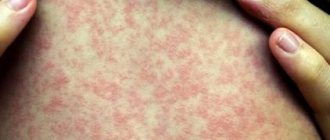Intestinal infection in children, causes:
- The emergence and proliferation of intestinal infection pathogens is facilitated by deviations from sanitary and epidemiological norms and living conditions of the child. Unsanitary conditions are a favorable environment for viruses and bacteria: this problem can often be encountered in kindergartens and schools, where low-quality, spoiled or poorly prepared food products become sources of outbreaks of viral diseases.
- The occurrence of disease is affected by poor water quality
- Presence of disease carriers in food units of institutions: these can be insects, animals
- Failure to comply with personal hygiene rules
Treatment of intestinal infection
The treatment tactics for intestinal infections directly depend on the type of causative agent of the disease, the severity and the presence of concomitant disorders in the body.
When treating pathology, doctors set themselves several tasks at once: to eliminate the onset of infection, prevent dehydration, relieve unpleasant symptoms and restore the normal functioning of the child’s body. For this purpose, the child is prescribed the following groups of medications:
- glucose-saline solutions for oral rehydration;
- antibiotics (for bacterial forms of the disease);
- antifungal drugs (for fungal infections);
- intestinal antiseptics;
- antipyretics;
- sorbents to prevent intoxication of the body.
In addition to drug therapy, parents need to provide the patient with dietary nutrition that is gentle on the child’s stomach and intestines.
Heavy foods can aggravate the condition and delay recovery. In case of an intestinal infection, it is necessary to reduce the amount of food consumed, drink plenty of water, and give preference to pureed or liquid easily digestible food. Fatty, fried, smoked and highly salted foods, fatty meats, fruits, dairy products, juices and carbonated drinks are excluded.
Intestinal infection: pathogens among children
The causative agents of intestinal infections can be a large group of pathogenic bacteria, viruses, protozoa; in pediatric practice the most common are:
- dysentery bacilli
- coli
- rotaviruses (“dirty hands disease”)
- viruses that infect the intestinal lining
- infection with lamblia, amoebas, staphylococci and other representatives of protozoa
Intestinal infections are quite tenacious, they are able to exist even in extreme conditions: they are not afraid of cold, are able to remain in soil and water for a long time, are able to multiply quickly, the incubation period after they enter the stomach takes a short period of time, bacteria and viruses quickly take over the area intestines. Infectious agents can enter the human body in several ways: through the oral cavity and through household contact. Not only individual manifestations of the disease are possible, but also epidemics. Unfortunately, the list of all infectious disease pathogens has not yet been studied; new discoveries in the field of this type of disease are constantly appearing.
Diagnosis of intestinal infection
Diagnosis of intestinal infections is carried out on the basis of the clinical picture of the disease and the results of laboratory tests. The difficulty of diagnosis lies in the similarity of the manifestations of intestinal infection with some gastrointestinal diseases, for example, acute appendicitis, lactase deficiency, poisoning, etc. That is why parents should not exercise excessive independence in diagnosing and treating pathology. You should entrust the child’s health to a qualified specialist with many years of experience in gastroenterology. After a thorough examination of the child and collection of the necessary anamnesis (medical history), the doctor sends the little patient for laboratory testing:
- stool culture to determine causative bacteria and their sensitivity to antibiotics;
- bacteriological culture of vomit contents;
- general clinical blood test;
- scatological analysis of stool.
To exclude pathologies of the gastrointestinal tract, ultrasound, MRI or CT may be additionally prescribed.
Intestinal infection in children: clinical picture, main symptoms of the disease
- As a rule, an infectious disease manifests itself sharply, immediately causing a number of characteristic symptoms: intoxication of the child’s body is accompanied by a feeling of lethargy, poor sleep, chills appear, body temperature also rises, appetite disappears, body mass index decreases
- This is followed by the second stage: infectious toxicosis. Toxicosis manifests itself in the form of neurological disorders, children may experience convulsions, and dehydration begins.
- in addition to dehydration, diarrhea, severe abdominal pain is the next signal of significant disturbances in the functioning of the gastrointestinal tract. The child's stool is characterized by an increase in frequency, scanty or copious discharge, changes in the consistency of the contents
Main forms of diarrhea:
- an invasive type of diarrhea caused primarily by bacteria and characterized by inflammation of the large intestine
- secretory type of diarrhea is caused by viruses or bacteria and affects the small intestine
- osmotic diarrhea is caused by an increase in the concentration of intestinal contents and, as a result, disruption of the digestive system
- Intestinal infection is characterized by vomiting; when assessing vomiting, attention should be paid to its duration, volume of vomit, and its nature
It is important to note that the clinical picture of the disease depends on which pathogens served as the “spot of fire” for the infection, and which part of the gastrointestinal tract was affected.
Dysentery
Clinic The incubation period ranges from 1 to 7 days (usually 2-3 days). The clinical picture of dysentery includes a syndrome of general intoxication, manifested by fever of varying severity, vomiting, dysfunction of the cardiovascular and central nervous system (CNS), and colitic syndrome (cramping abdominal pain, spasm and tenderness of the sigmoid colon, tenesmus, frequent loose stools with the presence of pathological impurities in the stool - mucus and blood). The nature and severity of the clinical manifestations of the disease are determined by the type of pathogen and the dose of the infection. Shigella Grigoryez-Schiga determines severe forms of dysentery, and Shigella Sonne determines mild forms. When food products are massively infected with Sonne's dysentery bacillus, severe forms of the disease develop as a toxic infection. According to the classification of A.A. Koltypin (1938), dysentery is divided into:
1. Typical forms: with a predominance of toxic phenomena; with a predominance of local inflammatory process; mixed forms. 2. Atypical forms: erased (colitis); dyspeptic and hypertoxic. According to severity, forms are distinguished: mild (erased, asymptomatic or latent), moderate and severe. The course of dysentery can be acute (up to 1 month), prolonged (1-3 months) and chronic (over 3 months).
A mild form of dysentery is characterized by an increase in body temperature to 37.5 ° C, single vomiting, and minor abdominal pain. Stool 4-6 times a day. The stool is liquid or mushy, with an admixture of mucus and green matter, and only in some patients it is streaked with blood. The sigmoid colon is palpably compacted.
The moderate form of dysentery begins with an increase in body temperature to 38-39 ° C, vomiting, and cramping pain in the abdomen before defecation. Stool 10-15 times a day. The feces are liquid , scanty, mixed with cloudy mucus, greenery and streaks of blood. Some patients may experience tenesmus. The sigmoid colon is dense, spasmodic. The pulse is increased. Blood pressure (BP) is slightly reduced.
The severe form of dysentery has a violent onset. Body temperature rises sharply to 39.5-40° C, chills, repeated vomiting and severe abdominal pain appear. Severe intoxication quickly develops, the central nervous system is affected - adynamia, agitation, fibrillary twitching of individual muscles. Possible convulsions, loss of consciousness, meningeal syndrome; cardiovascular activity is impaired: pallor, cyanosis, cold extremities, frequent, weak pulse, decreased blood pressure. Stools are frequent, up to 20 times a day. The feces are liquid, scanty, mixed with mucus, blood and pus. Cramping pain in the abdomen, tenesmus, the sigmoid colon is dense, spasmodic, sharply painful. A severe form of dysentery can be with a predominance of general toxic or local syndrome.
The erased form of dysentery occurs without intoxication and with mild intestinal dysfunction. Stool 3-4 times a day, stool is mushy or liquid, with a small admixture of mucus. The diagnosis is confirmed bacteriologically. The asymptomatic (latent) form of dysentery does not manifest itself clinically. Isolation of Shigella and an increase in the titer of anti-dysentery antibodies over time indicate the presence of an infectious process.
Chronic dysentery can be in the form of a continuous, recurrent and asymptomatic form. Currently, the proportion of chronic dysentery is 1-2% among all forms of dysentery.
In young children, dysentery has a number of clinical features: 1. the phenomena of general intoxication prevail over the colitic syndrome; 2. intestinal toxicosis often develops; 3. there is a tendency to a protracted, chronic course of the disease and the development of complications.
Consequences of intestinal infection in children:
- acute gastritis - inflammation of the gastric mucosa, accompanied by vomiting due to intoxication, abdominal pain and a feeling of heaviness, stool has a strong and fetid odor, gastritis can cause stomach ulcers and develop into a chronic disease
- colitis is an inflammatory lesion of the large intestine, in which the child’s stool is saturated with pathological impurities (cloudy mucus, blood clots), small volume and unpleasant odor are accompanied by recurrent pain
- Enteritis is observed when the small intestine is affected. The child's stool becomes more frequent, becomes liquid, throughout the entire illness, severe pain in the abdomen appears, undigested food comes out along with feces, the smell of the discharge is sour
When symptoms of an intestinal infection appear, the infectious disease specialist will prescribe an examination of the child’s vomit and feces to detect pathogenic microbes.
Principles of treatment of intestinal infection, modern approaches:
Almost all intestinal infections quickly make themselves felt. Once pathogenic microbes enter the body, it takes 6 to 48 hours to damage the gastrointestinal tract. Long-term research in the field of infectious diseases in modern practice has made it possible to identify complex therapy: the fight against pathogens takes place in several stages, rapid intervention and the use of solutions and drugs can achieve high efficiency and prevent serious consequences, which is especially important for children in the first years of life.
- If there is an imbalance in the intestinal environment, it is necessary to ensure the optimal composition of the child’s diet. Therapeutic nutrition is a leading component throughout therapy. Infants are advised to consume fermented milk mixtures; if carbohydrate absorption is impaired in children, on the contrary, it is necessary to use low-lactose mixtures; dairy-free porridges are used as complementary foods for older children.
- After the child’s recovery, mixtures enriched with bifidobacteria and lactobacilli are prescribed to improve intestinal microflora
- The child's diet should avoid rough foods that increase bloating.
- In severe forms of the disease, protein deficiency may appear, which is why doctors recommend consuming mixtures rich in protein and foods rich in protein (cottage cheese, fish)
- One of the main methods of therapy is based on restoring the balance of water and microelements, normalizing the water-salt balance, as well as restoring immunity; children are prescribed solutions containing glucose, salt, sodium
- A method of treating infection with the help of antibacterial drugs and treatment based on the introduction into the body of viruses that infect bacteria - bacteriophages. Bacteriophages have a beneficial effect on the intestinal microflora; their intake strengthens the body’s protective system
- Among the promising drugs in the treatment of intestinal microflora are probiotics; their use significantly reduces the time of a child’s illness. It is worth noting that probiotics can act as independent treatments for secretory type diarrhea. They help normalize the quantitative and qualitative composition of microflora and reduce the amount of antibacterial therapy. The use of probiotics is useful for the prevention of gastrointestinal diseases
In conclusion, I would like to draw your attention: it is possible to protect yourself from intestinal infections. It is enough to follow the basic rules of prevention: maintain hand hygiene after any contact with the external environment, wash vegetables and fruits, monitor the quality of water, drinks and foods consumed. For preventive purposes, use probiotics in spring and autumn to strengthen the body's defenses and saturate the body with vitamins and biologically active substances.
Staphylococcus
Food poisoning
This form is the most accessible form of the disease for diagnosis. The incubation period is short - from 3 to 6 hours. The disease occurs: acutely, after eating food contaminated with staphylococcus. During the first day after a food error, children develop severe toxicosis (body temperature rises, repeated vomiting); frequent loose, watery stools with a small admixture of mucus (rarely with blood) are observed. The symptoms of toxicosis rapidly increase: there is severe anxiety, sometimes loss of consciousness, and severe thirst. The serious condition of children requires urgent measures to combat developing toxicosis and exicosis. With timely assistance, patients recover quickly.
Enteritis and enterocolitis in young children
This form of intestinal damage can be primary (staphylococcus enters the body with food) and secondary (the pathogen spreads from other foci). Primary enterocolitis begins acutely: body temperature rises, vomiting, frequent stools (profuse, watery, yellow-green); Exicosis and toxicosis develop, expressed to varying degrees. Weak children who are predominantly bottle-fed or mixed-fed are affected. Often this disease is preceded by a viral infection. Pathogenic staphylococcus is isolated from feces from the first days of illness, usually in large quantities. Blood testing is of significant value, since staphylococcal bacteremia is quite common and can be observed for a long time.
Secondary enteritis and enterocolitis in young children are either a manifestation of a generalized staphylococcal infection or arise as a result of intestinal dysbiosis. In these cases, damage to the gastrointestinal tract is not isolated, but joins other foci of staphylococcal infection, and the latter are often leading in the clinical course of the disease (pneumonia, otitis media, staphyloderma). The disease can even begin with catarrhal phenomena in the upper respiratory tract, vomiting, and increased frequency of stools from 3-6 to 10-15 times a day. The stool is liquid, with the presence of mucus, greenery, and less often - streaks of blood. Body temperature is subfebrile, with occasional rises. Children do not gain weight well. The disease takes a long, undulating course with periods of improvement and deterioration. Complications (otitis media, pneumonia) are rare. With timely and correct treatment, recovery occurs.
Acute intestinal infections are caused by several groups of microorganisms - bacteria, viruses and protozoa.
The source of infection is a person or animal.
Leading transmission routes:
- contact-household (through contaminated household items, toys, pacifiers, dirty hands)
- food (when eating insufficiently processed, poor-quality food products)
- water (when drinking unboiled water, swimming in open water)
Predisposing factors for the occurrence of intestinal infections are:
- artificial feeding;
- introduction of complementary foods that are not subject to heat treatment - there is a possibility of pathogens getting in with complementary foods;
- summer season - increased air temperature promotes the proliferation of pathogens in water, soil, and products;
- prematurity;
- immunodeficiency conditions in children;
- perinatal pathology of the central nervous system.
The entry gate and target organ is the gastrointestinal tract.
The main groups of symptoms of the disease are as follows:
- fever, weakness, loss of appetite
- diarrhea, vomiting, bloating
- stomach ache
The severity of the disease is indicated by sunken eyes, sharpening of facial features, sunken fontanel, dry lips, and convulsions.
A terrible symptom indicating the extreme severity of the disease is the absence of urine in a child for more than 6 hours.
For diarrhea accompanied by abdominal pain and signs of intoxication:
Do not use painkillers - this can make diagnosis very difficult. Painkillers can hide the manifestations of surgical diseases (appendicitis, acute cholecystitis and others);
You cannot use a heating pad, because... this can increase inflammation and cause a sharp deterioration in the child’s condition;
Do not do a hot water enema, especially if your temperature rises.
Do not give your child astringents (fixatives) for diarrhea - imodium, lopedium, etc. In this case, the course of the disease may become more complicated, because Instead of accelerating the removal of toxins from the body, you will provoke their accumulation.
For infectious diseases that occur with fever, diarrhea, vomiting; If you suspect a surgical disease, homeopathic remedies should never be used. Such conditions require consultation with a doctor and conventional therapy; Delay in prescribing traditional medicines can lead to dire consequences.
So, to avoid acute intestinal infections in children, you should:
- strictly observe the rules of personal hygiene, wash your hands often and thoroughly with soap, especially before eating and after visiting the toilet;
- use boiled, bottled or guaranteed quality water;
- Wash vegetables, fruits, berries thoroughly before consumption under running tap water, and for small children - boiled;
- use only clean packaging (polyethylene, food containers, etc.);
- do not purchase food products from random persons or places of unauthorized trade;
- observe hygiene rules when preparing hot and cold foods, expiration dates and storage conditions for food products, especially perishable ones; raw foods and prepared foods should be stored separately;
- thoroughly fry or boil foods, especially meat, poultry, eggs and seafood;
- perishable foods and prepared foods should only be stored in the refrigerator at a temperature of 2-6°C;
- Do not mix freshly prepared food with leftovers from the previous day, but if prepared food is left for another day, it must be heat treated (boiled or fried) before consumption.
- do not accumulate garbage and food waste, do not allow flies and cockroaches to appear;
- Always keep your home clean and observe the rules of personal hygiene, do not give small children unboiled bottled milk or raw eggs, use only fresh food for cooking.
Dysentery, or shigellosis , is an acute infection of the large intestine, in particular its lower section.
This disease is caused by dysentery bacteria, which, when they enter the large intestine, affect its mucous membrane. The disease most often affects young children, especially between the ages of 2 and 7 years. However, this disease can also occur in infants. To expose your children to this disease as little as possible, you need to take preventive measures. The main source of infection is a sick child, who is dangerous from the first day of illness, since she releases a large number of bacteria with feces. Routes of transmission of the disease: Fecal-oral:
- water (when swimming in a pool, ponds, drinking unboiled water);
- food.
- Contact household - through dishes, toys, linen, dirty hands.
The peak incidence occurs in summer and autumn.
Symptoms of dysentery in children
Features of the clinical picture of the disease depend on the nature of the course, the type of pathogen, the extent of damage to the gastrointestinal tract and the child’s immunity.
The first signs of acute dysentery in children usually appear 2–3 days after infection.
The disease begins acutely, the child develops:
- general malaise;
- fever 37.5 – 40° C;
- nausea, vomiting;
- diarrhea up to 20 times a day, feces mixed with greens, blood, mucus;
- often false, painful urge to defecate;
- rumbling in the large intestine.
In severe cases, the following symptoms are added:
- depression of consciousness;
- tachycardia;
- hypotension;
- cyanosis of the skin;
- convulsions.
Prevention of dysentery
The risk of developing shigellosis can be reduced by:
- compliance with hygienic rules of strict control of water supply sources, conditions of storage and sale of food, boiling water;
- identifying patients in preschool and school institutions, among kitchen workers;
- carrying out sanitary and quarantine measures.
The doctor pays attention Make sure that the child’s hands are always clean. In conditions where there is no water, wipe your baby’s hands with wet wipes or treat them with antiseptic sprays.
For cooking or drinking, it is better to give a child under one year of age bottled quality water.
To prevent dysentery, wash children's toys once a week so that dirt and dust do not linger on them.
A sick child should not be force-fed. It is better to give your baby more liquid.
If your child has diarrhea, do not send him to kindergarten. Call a doctor to your home, save and show the doctor the baby’s last stool.
Despite the prevalence of the disease in children and the possibility of complete recovery, if diarrhea occurs in a child, it is necessary to urgently consult a doctor. Indigestion can indicate not only dysentery, but also a number of other foodborne toxic infections. Self-medication for shigellosis is unacceptable.
Pathogens of Salmonellosis
- bacteria of the genus Salmonella. They cause an acute infectious-toxic disease of varying severity, which is most often manifested by diarrhea, abdominal pain, nausea, vomiting, and general symptoms of intoxication (fever, chills, headache, muscle pain).
Salmonella remains viable: in dust, on household items for up to 80 days; in bird eggs up to 1 year; on eggshells for up to 3 weeks, in water for up to 5 months, in dried animal and human feces for up to 4 months. When boiled in broth, salmonella die within 5-7 minutes. To completely disinfect infected meat, pieces weighing 0.5 kg are needed. cook for at least 2 hours.
The incubation (hidden) period of the disease lasts from 2-6 hours to 7 days (on average 1-2 days).
For humans, the main sources of Salmonella are farm animals (cattle, pigs, sheep), poultry (chickens, geese, ducks). Salmonella enters the human body through consumption of contaminated food and is excreted in feces.
The leading factors in the transmission of salmonella are meat, meat products, poultry, poultry products, and eggs. Salmonella can enter an egg through a shell contaminated with secretions or transovarially (from an infected bird to the fetus).
The source of infection can also be a person sick with salmonellosis, or an apparently healthy bacteria carrier.
If personal hygiene is not observed, they can contaminate food with salmonella through dirty hands and kitchen utensils (dishes, knives, cutting boards).
The danger of spreading the infection especially increases if a person with salmonellosis or a bacteria carrier works in public catering facilities, trade, food industry enterprises or prepares food at home.
Salmonella in food can not only persist for a long time, but also multiply intensively under favorable conditions. Salmonella does not change the appearance, color, smell, or taste of food. At room temperature, the number of salmonella in meat increases 140 times per day. Salmonella multiply especially quickly in minced meat, jellied meats, and pates. salads, including those with mayonnaise.
People are highly susceptible to salmonella. Children are especially susceptible to this infection.
A mother with salmonellosis (or a carrier of the bacteria), if hygiene rules are not followed, can infect the child during care, breastfeeding, and preparing formula.
To prevent the spread of salmonellosis in the room where an infant is located, routine wet cleaning is carried out daily using detergents; dust accumulation on furniture and household items is not allowed; the room is ventilated 3-4 times a day. General cleaning is carried out at least once every 7 days.
A specific place in the room is allocated for feeding an infant. Before feeding the baby, the mother must wash her hands twice with soap, then wipe them dry with a disposable napkin or individual towel. When using expressed breast milk for feeding, expressing is carried out in a sterile (boiled for 30 minutes) bottle. Use breast milk immediately after pumping.
It is best to prepare infant formula immediately before each feeding. The prepared mixtures are used within 3 hours from the moment of preparation. Used bottles are washed with running water, soaked for 15-20 minutes in a 2% solution of baking soda, then thoroughly washed with hot water. Bottles are washed using a brush. The washed bottles are dried and disinfected by boiling for 30 minutes, then dried and stored in conditions that prevent their contamination.
After processing the dishes, the brushes are washed with running hot water and dishwashing detergent, boiled for 30 minutes, and stored dry.
The nipples are washed with running water, soaked for 15-20 minutes in a 2% solution of baking soda, then rinsed thoroughly with hot water. Disinfect by boiling for 30 minutes in a specially designated container. After boiling, the water is drained without removing the lid and stored in the same container until next use.
In the process of swaddling a child, hygiene rules are observed, aimed at preventing possible contact of pathogens of infectious diseases with the skin and mucous membranes of the child. A specific place or table is allocated for changing. The mother's clothes should be kept clean. Before changing (undressing) a child, you should wash your hands, soap them twice, and dry them thoroughly with a disposable napkin. Wash the child under warm running water. A washed child is dried with a disposable napkin or an individual towel. Used nappies (diapers) are collected in a plastic bag, which is removed from the children's room after the procedure is completed.
Young children are especially susceptible to the disease. They can become infected from sick peers through infected nipples, toys, dishes, and underwear. Toys that a child puts in his mouth must be washed daily using detergents and rinsed thoroughly under running water. Dishes and linen should be used individually by children.
If the mother or other family members develop symptoms of an acute intestinal disease, it is necessary to immediately consult a doctor; it is better to hospitalize the sick person in an infectious diseases hospital to prevent infection of the child.
To avoid salmonellosis, follow these simple rules:
- When preparing food, before eating, and after visiting the toilet, you must wash your hands thoroughly with soap.
- If there is a person with salmonellosis in the family, then personal hygiene rules must be observed especially carefully.
- Do not eat raw eggs - they should be boiled for at least 10-12 minutes from the moment of boiling or thoroughly fried on both sides. Meat and poultry must be thoroughly boiled or fried in portions so that the juice inside the piece is colorless and transparent.•
- Store raw foods and semi-finished products separately from prepared dishes in disposable packaging, and for cutting them use separate kitchen equipment - boards, knives.•
- After cutting meat, poultry, and raw semi-finished products, thoroughly wash kitchen equipment (meat grinder, knives, cutting boards, dishes) with hot running water and detergent.•
- After cutting meat, poultry, and raw semi-finished products, thoroughly wash your hands with detergent, wipe them dry with a disposable napkin, and only then proceed to preparing other dishes.•
- It is better to cook dishes and products stored in the refrigerator for more than 24 hours before use (fry meat, cutlets, sausage, boil soup, make cheesecakes or casserole from cottage cheese).•
- Prepare dishes in quantities necessary for one-time consumption, be sure to observe personal hygiene measures, food preparation technology, especially the duration of their heat treatment.•
- Do not store prepared dishes, salads, or pastries with cream for more than 2 hours outside of refrigerators in order to prevent the growth of salmonella and other pathogenic microbes in them.•
- Do not take boiled eggs, boiled sausages, salads, cream confectionery, meat dishes, poultry dishes, cottage cheese, etc. on the road; if the dishes are freshly prepared, use them within the first 2 hours.•
- We remind mothers that young children are especially susceptible to salmonellosis, so infant formula should be prepared for one feeding; opened jars of baby food and juice should be used within the first 2 hours.•
- Teach children the skills of personal and public hygiene, conduct awareness-raising work on the prevention of salmonellosis among adolescents, especially in the summer and on vacation.
Remember! If the first signs of intestinal illness appear, consult a doctor immediately
We wish you and your children health!!!
Prevention of intestinal infection
In order to prevent the development of intestinal infection, parents must adhere to the following preventive rules:
- From a very early age, develop primary personal hygiene skills in your child.
- Carefully monitor the cleanliness of the child’s hands and ensure the cleanliness of the objects surrounding the baby.
- Drink only clean water.
- Carefully process fruits and vegetables before giving them to your child.
- Regularly wet clean your home with disinfectants.
If your baby does develop an intestinal infection, you should immediately seek medical help from a specialist. Doctors at the SM-Doctor clinic for children and adolescents will help you quickly identify the disease and prescribe the necessary treatment.








